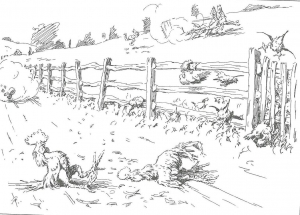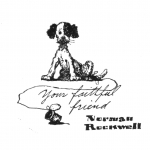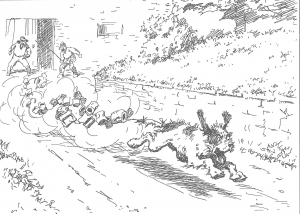
A. B. Frost (1851- 1928) | Carlo Starts for Home | Cartoon from Carlo (New York: Doubleday & Co., 1913)
While living in France between 1906 and 1913, Arthur Burdett Frost created a series of drawings about a beleaguered dog named Carlo.* The compiled drawings of Carlo, published in 1913 by Doubleday, were read as episodes of the dog’s life. Frost’s skill in depicting motion and sequence, would later influence American comic artists like Richard Outcault and Fred Opper. Frost is even credited with creating the first sequential illustrations that eventually evolved into cartoon strips.
Frost’s illustrations that intrigue me are the sequence that details Carlo’s fright-filled run down a road after an assortment of tin cans tied together are attached to his tail. As you can see in this illustration, the noise from the cans frightens the dog and he takes off running in an attempt to get away from the din. As he runs down the road the cans attached to his tail churn up a cloud of dust and dirt behind the dog. Notice that at the end of the string, the last can, so to speak, is in fact a lidless tea kettle. In subsequent drawings Frost used the image of the cloud with a couple of cans distinctly detailed in the cloud as the drawn short-hand for the dog and his plight. The later images show the dust cloud and the tag lines narrate the action of some of the sequences. For example,
Carlo and his cans (the cloud of dust and cans at the upper far left of this next picture) disrupted a fight between two roosters who were about to see who would be ‘cock of the walk.’ Notice how the rooster at the right has just bit the dust. In a later cartoon, just before the dog arrives home, the string of cans meet up with a man walking down the road and engulfs the unsuspecting man leaving the dog’s tail once again unencumbered. The dogs is then shown sitting in front of his dog house and the narration reads, “Look at his tail, Patrick, it’s all swolled up.”
As terrible is the notion of tying a tin can to a dog’s tail due to its basic cruelty, it became a story device in early movies, published sheet music (as seen below in the cover of a piece of popular music from 1922 **) and even a painting of the subject by the American illustrator Walter Beach Humphrey.
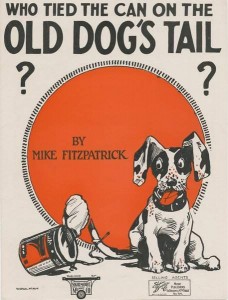
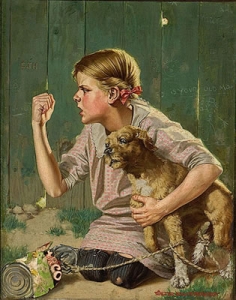 Walter Beach Humphrey (1892-1966) Dog with Can Tied to Its Tail, c. 1920s
Walter Beach Humphrey (1892-1966) Dog with Can Tied to Its Tail, c. 1920s
A beleaguered looking Patsy (Did Rockwell chose this name because the dog was a patsy?) was Rockwell’s focus when he created an alter-ego image for himself. While he signed himself, ‘Your faithful friend’, the image of the tin can tied to the dog’s tail implies a different story. As Rockwell clearly shows in the dog’s dismayed expression, having a tin can tied to your tail means that something (a story, a responsibility, or a situation) is chasing you from behind or is a reference to you of which you cannot ever be rid. It makes this dog a benighted figure constantly being chased by a noisy tin can.
In the mid-1920s Rockwell and Arthur Burdett Frost met one another. At this meeting, Frost gave Rockwell an illustration drawing of an Old Farmer created in 1887 and inscribed it “To Norman Rockwell from A. B. Frost. 1925.” Around this same time, Rockwell adopted his version of the beleaguered dog to use as part of his closing salutation. By making his version of the Patsy dog character into his alter-ego caricature, Rockwell was harkening back to one of Frost’s signature characters.*** The continuum of illustration art was there all the time. Frost’s Carlos may indeed be the source for Rockwell’s ‘faithful friend.’ All we needed to do was to tie the various tin cans together to see that the two were connected.
* My thanks to David Apatoff for encouraging me to look at Frost’s work again.
** Published by Skidmore Music Company of New York and illustrated by an unidentified illustrator named only Wohlman.
*** One of my favorite versions of this sign-off image was used in an undated note to Rockwell’s Stockbridge Doctor. In this instance the dog is drawn with Rockwell’s pipe in his mouth.
May 31, 2012
By Joyce K. Schiller, Curator, Rockwell Center for American Visual Studies, at the Norman Rockwell Museum


